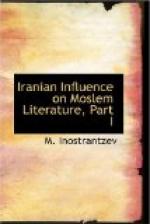Ibn Khallikan adds that “Mihyar and Mirzawaith are both Persian names. Their signification is unknown to me.”
VOLUME III.
Instances of hybrid compound names, the Iranian component being retained.
Izz ad-Din Kaikaus son of Ghiath ad-Din Kaikhosru. (P. 487).
Ala ad-Din Kaikobad. (P. 489).
Abu Mahfuz Ibn Firuz. (P. 384).
Abu Manzur Al Muzaffar Ibn Abi I-Husain Ardeshir. (P. 365).
Abu Mansur-Sheherdar Ibn Shiruyah. (P. 11).
Sultan ad-Dawlat, Fanakhrosru (which is no doubt equivalent
to Panah
Khurso.) (P. 278).
The word abna signifies sons. It was generally employed to designate persons one of whose parents was an Arab and the other of a foreign race. At the time of Mahomed and afterwards there was in Yeman a great number of Abna whose fathers were Persians and whose mothers were Arabs. (P. 334).
Dress of the Ulema. (P. 273).
Yahya Ibn al Munajjim whose real name was Abban Hasis, the son of Kad, the son of Mahavindad, the son of Farrukhdad, the son of Asad, the son of Mihr, the son of Yezdigerd, the last of the Sasanian kings of Persia.
Story of the onagar with the inscription on its ear written by Bahramgor in the Kufic character. Ibn Khallikan quotes Al Khawarezmi’s Mafatih-al-Ulum. (P. 85).
[Sidenote: Old castles.]
Istakhri refers to the castle of Jiss in the district of Arrajan about which we have a more exhaustive notice by other writers. “Here lived the Magians,” says Istakhri, “and here also are to be found memorials of the past of Persia. The place is strongly fortified. The castle of Iraj is also strongly fortified. The fastnesses which cannot be subjugated are so many that it is not possible to detail them.”
Describing the city of Jur Istakhri says that it was built by Ardeshir. “It is said that here water used to be collected as in a lake. The king had taken a vow to build a city and to erect a fire temple at the place where he had defeated his enemy. He had the place drained, and when it was dried he built the city of Jur on the site. The city in its extent is like Istakhr, Sabur, and Darabgird. It had mud walls and moats and many gates, the eastern one being called the gate of Mihr, the western the gate of Bahram, the northern the gate of Hormuz, and the southern the gate of Ardeshir. In the centre of the city is a building with a cupola built by Ardeshir. It is said that it is so high that it commands a view of the city and its surroundings. High at its top is a fire altar.[1]” (P. 56).
[Sidenote: Languages of Iran.]
In another portion of his book Istakhri describes the inhabitants as thin, with little growth of hair and of brown colour. “In the colder tracts,” he continues, “the people are of a taller stature with a thick growth of hair and very fair. They speak three languages,—the Parsi, which everybody speaks and which is employed in their letters and their literature; the Magians who dwell among them use the Pahlavi in their writings, but it needs for a thorough understanding an explanation in Parsi; and Arabic which is the language used in the correspondence of the Sultan, the Government Boards, the grandees and the Amirs.” (P. 67).




